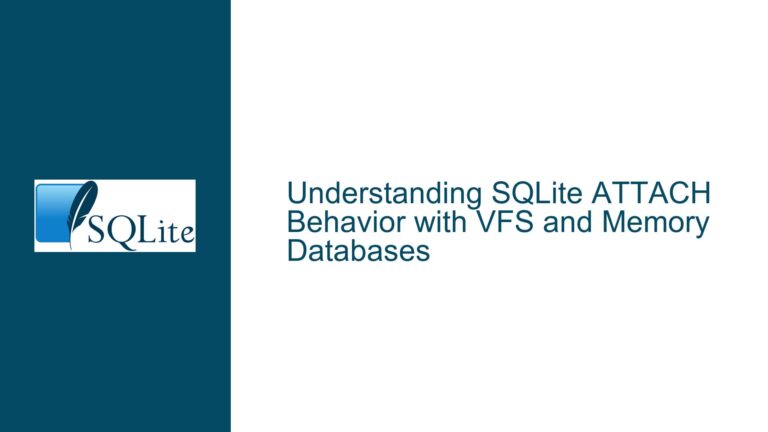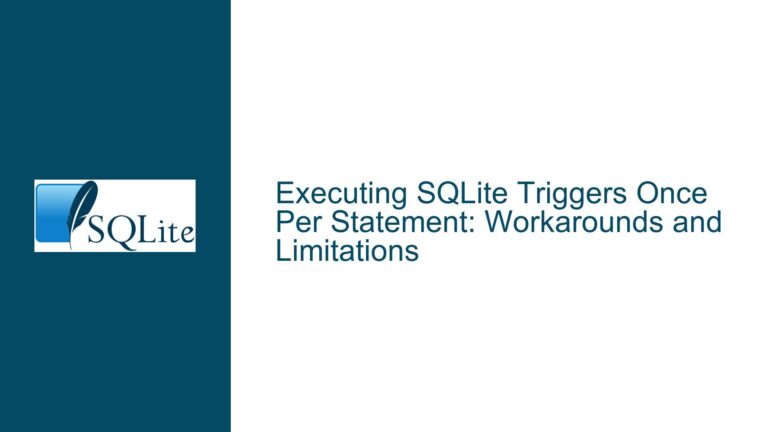Securing and Relocating SQLite Database in React Native for UWP Applications
Issue Overview: Database Location Customization and Encryption Challenges in React Native UWP
The core challenges revolve around two distinct but related technical hurdles faced when integrating SQLite into a React Native-based Universal Windows Platform (UWP) application. The first is the inability to customize the default database storage location from the system-managed %LOCALAPPDATA% directory to a user-specified path such as the Documents folder. The second is the failure to enforce encryption on the SQLite database despite using third-party libraries like react-native-sqlcipher and react-native-sqlcipher-storage. These issues are compounded by the unique constraints of the UWP sandboxed environment, React Native’s abstraction layer over native modules, and misunderstandings about SQLite’s encryption support.
Technical Context and Constraints
- UWP File System Permissions: UWP applications operate within a sandboxed environment where access to certain directories (e.g.,
C:\Users\...\Documents) requires explicit capabilities declared in the app manifest. The defaultLocalStatedirectory is automatically writable without additional configuration. - React Native SQLite Integration: React Native modules like
react-native-sqlite-storageabstract platform-specific details, but path handling may differ between Android, iOS, and Windows. Incorrect path formatting or insufficient permissions can lead to silent failures. - SQLite Encryption Limitations: Vanilla SQLite does not natively support encryption. Solutions like SQLCipher or SQLite’s commercial SEE (SQLite Encryption Extension) require compiling custom binaries or using pre-wrapped libraries. Misconfiguration of these dependencies often results in encryption being bypassed.
Possible Causes: Path Handling Errors and Encryption Misconfigurations
1. Incorrect Path Specification for Database Location
- Missing Escape Characters: The user’s code snippet uses
C:Userskambhampati.murthyDocuments, which lacks backslashes (\). In JavaScript string literals, backslashes must be escaped as double backslashes (\\). The correct path should beC:\\Users\\kambhampati.murthy\\Documents. - UWP File System Virtualization: Even with a correctly formatted path, UWP apps may redirect file operations to virtualized directories unless the
broadFileSystemAccesscapability is enabled in thePackage.appxmanifestfile. This capability is restricted and requires user consent. - React Native Module Limitations: The
openDatabasemethod’slocationparameter may not support absolute paths on all platforms. Some React Native SQLite modules default to platform-specific directories (e.g.,LocalStateon Windows) and ignore user-provided paths unless explicitly configured.
2. Ineffective Database Encryption
- SQLCipher Integration Failures: The
react-native-sqlcipherandreact-native-sqlcipher-storagepackages depend on native SQLCipher binaries. If these binaries are not properly linked during the build process, the encryption layer is absent, allowing the database to open without a key. - Key Parameter Ignored: The
openDatabasemethod’skeyparameter may be omitted or passed incorrectly. For example, if the key is not provided as a string or buffer, SQLCipher defaults to using a null key, effectively disabling encryption. - SEE vs. SQLCipher Confusion: SQLite’s official encryption offering (SEE) is a commercial product, while SQLCipher is an open-source fork. Mixing components from these two can lead to compatibility issues, such as mismatched encryption algorithms or unsupported APIs.
3. Platform-Specific Behavior and Debugging Gaps
- Silent Failures in UWP: File system operations in UWP often fail silently due to permission mismatches. For example, attempting to write to
C:\Users\...\DocumentswithoutbroadFileSystemAccessresults in the database being created in a virtualized store, which is not visible to the user. - Insufficient Error Handling: The provided code logs errors generically (
console.error('Error opening database', error)) but does not inspect the error object’s details. SQLite errors often include platform-specific codes (e.g.,SQLITE_CANTOPEN) that pinpoint the cause of failure. - Misinterpretation of Encryption Success: Without verifying the database’s encryption status using external tools (e.g., DB Browser for SQLite with SQLCipher support), developers may assume encryption is active when it is not.
Troubleshooting Steps, Solutions & Fixes
1. Resolving Database Location Customization Issues
Step 1: Validate Path Formatting and Permissions
- Escape Backslashes in Paths:
// Incorrect const dblocation = 'C:Userskambhampati.murthyDocuments'; // Correct const dblocation = 'C:\\Users\\kambhampati.murthy\\Documents'; - Enable
broadFileSystemAccessin UWP:- Open
Package.appxmanifestin Visual Studio. - Add the following under
<Capabilities>:<Capability Name="internetClient" /> <rescap:Capability Name="broadFileSystemAccess" /> - Declare the
rescapnamespace in the<Package>element:xmlns:rescap="http://schemas.microsoft.com/appx/manifest/foundation/windows10/restrictedcapabilities" IgnorableNamespaces="uap rescap"
- Open
- Verify Path Accessibility:
Use theWindows.StorageAPI to check if the target directory is accessible:async function verifyDocumentsAccess() { try { const folder = await Windows.Storage.StorageFolder.getFolderFromPathAsync('C:\\Users\\kambhampati.murthy\\Documents'); console.log('Access to Documents folder granted'); } catch (error) { console.error('Access denied:', error); } }
Step 2: Test Absolute vs. Relative Paths
- Use Platform-Specific Directories:
React Native’sreact-native-sqlite-storagemodule supports platform-agnostic path aliases:// Windows-specific absolute path const dblocation = Platform.OS === 'windows' ? 'C:\\Users\\kambhampati.murthy\\Documents' : '/data'; - Fallback to Default Locations:
If absolute paths fail, write to theLocalStatedirectory first, then move the database:const sourcePath = `${Windows.Storage.ApplicationData.current.localFolder.path}\\myDB.db`; const targetPath = 'C:\\Users\\kambhampati.murthy\\Documents\\myDB.db'; await Windows.Storage.StorageFile.getFileFromPathAsync(sourcePath).moveAsync(targetPath);
Step 3: Debug File System Operations
- Log Full File Paths:
Print the resolved path before opening the database:console.log('Attempting to open database at:', dblocation); - Inspect Virtualized Stores:
Use theApplicationDataAPI to list files in virtualized directories:const localFolder = Windows.Storage.ApplicationData.current.localFolder; const files = await localFolder.getFilesAsync(); files.forEach(file => console.log('Found file:', file.name));
2. Enforcing Database Encryption with SQLCipher
Step 1: Ensure Correct SQLCipher Integration
- Rebuild Native Modules:
SQLCipher requires replacing the default SQLite library in the React Native module. For Windows:- Clone the
react-native-sqlcipher-storagerepository. - Replace
sqlite3.candsqlite3.hin thewindowssubproject with SQLCipher’s versions. - Rebuild the module using Visual Studio.
- Clone the
- Verify Encryption at Runtime:
Open the database without a key to check if encryption is enforced:try { const db = SQLite.openDatabase('myDB.db', '1.0', 'Test DB', 0); console.error('Encryption is NOT active!'); } catch (error) { console.log('Encryption is active:', error.message.includes('file is encrypted')); }
Step 2: Validate Key Handling
- Pass Keys as Strings or Buffers:
// Correct const db = SQLite.openDatabase({ name: 'myDB.db', location: 'C:\\...', key: 'supersecret123' }); - Use Key Derivation Functions (KDF):
SQLCipher defaults to 256,000 iterations of PBKDF2. Ensure the key is sufficiently long:const crypto = require('crypto'); const key = crypto.randomBytes(32).toString('hex'); // 256-bit key
Step 3: Cross-Check with External Tools
- Inspect Database with DB Browser for SQLite:
- Install DB Browser with SQLCipher support.
- Attempt to open the database file without a key. If successful, encryption is not applied.
- Use the
PRAGMA cipher_version;command to confirm SQLCipher is active.
3. Platform-Specific Workarounds and Best Practices
Step 1: Leverage URI Filenames for Cross-Platform Consistency
- Encode Paths as URIs:
const dbUri = `file:${dblocation}\\myDB.db?mode=rwc`; const db = SQLite.openDatabase({ name: dbUri, createFromLocation: 0 }); - Handle Windows-Specific URI Issues:
Convert backslashes to forward slashes in URIs:const dbUri = `file:/C:/Users/kambhampati.murthy/Documents/myDB.db`;
Step 2: Implement Fallback Security Measures
- Encrypt Sensitive Data at the Application Layer:
Use libraries likereact-native-aes-cryptoto encrypt individual fields before storage:const encryptedData = await Aes.encrypt('plaintext', 'secretKey'); - Enable Windows BitLocker for Device-Level Security:
While not app-specific, BitLocker encrypts the entire drive, adding another layer of protection for databases stored in user directories.
Step 3: Monitor and Audit Database Operations
- Log All Database Interactions:
WrapopenDatabasecalls with logging:function openDatabaseWithLogging(config) { console.log('Opening database with config:', config); return SQLite.openDatabase(config); } - Use SQLite Trace APIs:
Enable tracing to capture low-level database events:SQLite.enableTrace(true); SQLite.enableErrorLogging(true);
By systematically addressing path formatting, UWP permissions, SQLCipher integration, and encryption validation, developers can successfully relocate and secure SQLite databases in React Native UWP applications.






